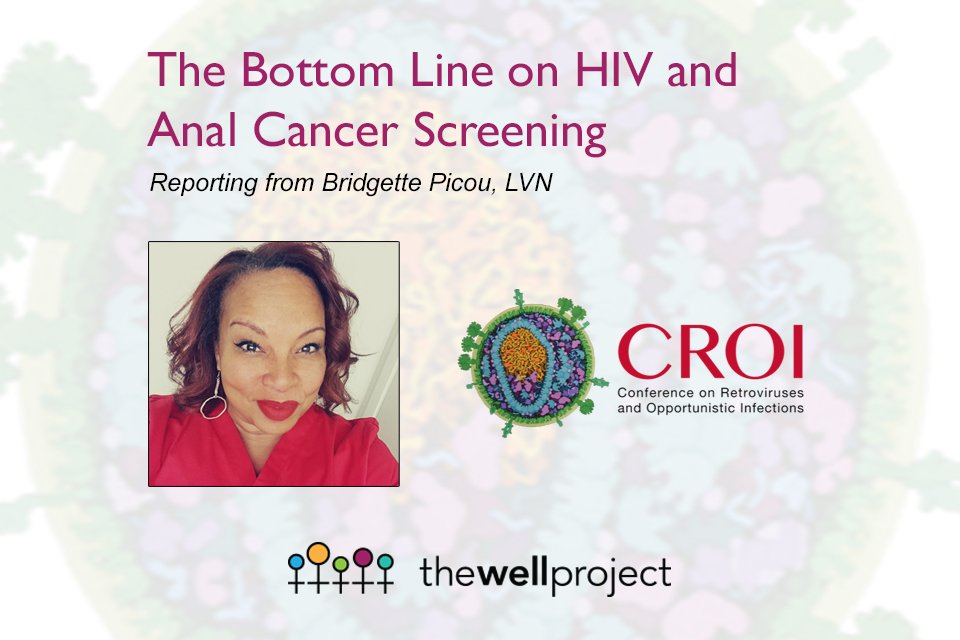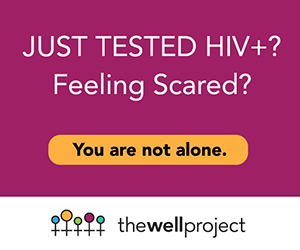By Bridgette Picou, LVN
The world's leading HIV science meeting took place virtually yet again in February 2022, and three of The Well Project's Community Advisory Board members were in attendance. Read on for one community author's take on key studies from the Conference on Retroviruses and Opportunistic Infections (CROI 2022) – and check out all The Well Project's coverage of this exciting conference.
At the CROI 2022 conference this year I was pleased to see a session on a study I actually assisted on in my work as a nurse. It made me feel like I had contributed to science, no matter how minutely, and I am happy to share my takeaways and what I learned.
Anal cancer incidence is much higher among those living with HIV, for whom it is the fourth most common cancer.
The results of the trial, which was named the "ANCHOR Study," were presented by Joel Palefsky, MD, of the University of California at San Francisco, who was the lead investigator. I did not know ANCHOR was an acronym, although considering it is a study in medicine, I should have! The Anal Cancer HSIL Outcomes Research trial was designed to study screening interventions and treatment outcomes in relation to anal cancer among those living with HIV. HSIL stands for high-grade squamous intraepithelial lesions – these are abnormal changes to the cells on the surface of certain organs, also called dysplasia.
Anal cancer has not been particularly common to the population at large but rates have been rising for men and women since the 1970s. Anal cancer screening differs from colon cancer screening. Anal cancer, like cervical cancer, is most often caused by human papillomavirus (HPV). Not all strains of HPV are cancer causing, but prior research has shown that people living with HIV tend to have more types of HPV and are less likely to be able to clear the virus via their body's own immune system, leading to faster progression to cancer in some cases.
Anal cancer incidence is much higher among those living with HIV, for whom it is the fourth most common cancer. Men who have sex with men are at highest susceptibility, especially those who are older, followed by older men who do not have sex with men, and women living with HIV. Also vulnerable were women with other HPV-related cancers or pre-cancers and people with instances of compromised immunity other than HIV. A little-known fact is that actress Farrah Fawcett (of the Charlie's Angels TV show) died from anal cancer.
In the years since I learned about anoscopies and screening for anal cancer and have been talking about them to others, only one woman I mentioned it to had ever heard of an anal Pap smear (a swab, just like in a cervical Pap). Not a single heterosexual male I have spoken to has heard of it or been offered one, living with HIV or not. In fact, most clinicians do not know about the procedure in terms of screening for anal cancer. Furthermore, remarkably few are trained in how to do an anal Pap smear, as they require a good amount of skill to perform and take time to get good at. YIKES. This lack of knowledge – about vulnerability as well as amongst clinicians – is part of why I was glad to be a part of the study and also interested in the findings.
The study was stopped early because it was overwhelmingly showing that screening and treatment of HSIL reduced the risk of progression to cancer.
The results of this particular study also mattered to me for other reasons. Aside from the nurse-as-a-patient-advocate angle, learning about the effects of HPV was interesting, and the procedure used in the study was one of the first I learned to assist with in my career. I want to give you the picture of what anoscopy is before I share the study findings. Once an anal Pap determines to presence of HPV in the anus, the screening procedure can be done. It's called an anoscopy and the simplest way I know how to explain it is that it is comparable to a Pap smear in women, only it is done in the anus using a high-resolution camera to inspect the surface tissues and cells of the anus.
Briefly, the process is that the cells are highlighted with acetic acid (medical-grade vinegar), cross-stained (colored) with iodine, and viewed under the camera and microscope. Whether or not an area takes up the cross-staining is what alerts clinicians to areas of dysplasia, and is where the biopsies are collected to determine the level (measured in grades – 1, 2, or 3) of change. These are sent to the lab and are part of how the determination is made on what treatment will be recommended. Treatments consist of either hyfrecation (heat from an electric current) directly to the surface of the cells, topical creams or acids, infrared coagulation (light used to form a clot), or surgery in some cases.
Hopefully you aren't bored yet and are still with me! These were the basics of the study and its findings:
- The study was done across 15 cities and participants' ages started at 35
- Between September 2014 and August 2021, a total of 10,723 people with HIV were screened
- Median age of the randomized participants was 51 – 80 percent were men, mostly gay or bisexual; 16 percent were women; and about 3 percent were transgender. About a third were white, 42 percent were Black, and 16 percent were Latino. More than 80 percent were on HIV medications with an undetectable viral load and the average CD4 count was approximately 600.
- At study entry more than 53 percent of men, 63 percent of transgender people, and 46 percent of women were found to have HSIL. Seventeen of them had preexisting anal cancer. The prevalence of HSIL was higher than expected in the women in the study, who represented a group that had not commonly been screened before.
- The 4,446 individuals found to have HSIL in the study were randomly assigned to be treated or monitored (broken down as 2,227 assigned to immediate treatment, and 2,219 assigned to be monitored)
The study was stopped early because it was overwhelmingly showing that screening and treatment of HSIL reduced the risk of progression to cancer. The calculated incidence rate was 173 cases per 100,000 person-years and a 57 percent risk reduction. Nine people in the immediate treatment arm and 21 people in the active monitoring arm were diagnosed with invasive anal cancer. It was recommended that everyone in the monitoring arm be offered treatment, and study participants will continue to be followed. The study supports routine screening as part of the treatment of those living with HIV. You can now read more about this study and view a video of Palefsky's talk on the CROI website.
If you have never had an anal Pap, ask for one. Tell your friends to ask for one... It's not about male or female, or being gay or hetero. HPV is prevalent, relevant to your overall health, and you can't fix what you don't know.
For my part, I'd like to see an increase in the number of clinicians trained in screening procedure and treatment, as well as an increase in who screening is offered to and how often. This screening starts with a simple swab to determine the presence of HPV. If you have never had an anal Pap, ask for one. Tell your friends to ask for one. This is not about behavior or sexual orientation. It's not about male or female, or being gay or hetero. HPV is prevalent, relevant to your overall health, and you can't fix what you don't know.
Do yourself a favor and get screened. The more people ask and make clinicians aware, the more mainstream the screenings can become.
More on this study from our partner organization POZ Magazine: Screening and Early Treatment Cuts Anal Cancer Risk
More from The Well Project on the Conference on Retroviruses and Opportunistic Infections (CROI 2022)
- Promising Approaches to Test for, Prevent, or Treat HIV and Other STIs: A Recap from CROI 2022 by Marissa Gonzalez
- HEU, What's in a Name? or The Science in Perinatal HIV Exposure: A Recap from CROI 2022 by Bridgette Picou, LVN
- On COVID-19 Protection and HIV Remission: Recaps from CROI 2022 by Katie Willingham
- CROI Should Stand for Crying Ridiculously Over Incomprehension by Marissa Gonzalez on A Girl Like Me
- Nuances by Bridgette Picou, LVN, on A Girl Like Me
- My Inner Scientist by Katie Willingham on A Girl Like Me





